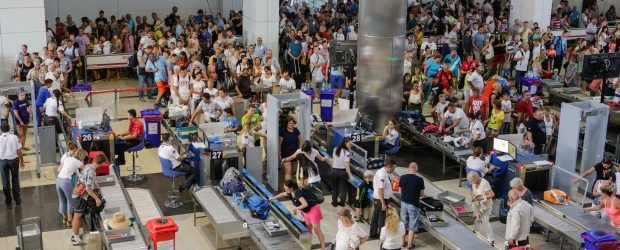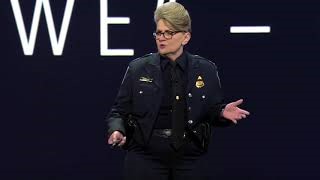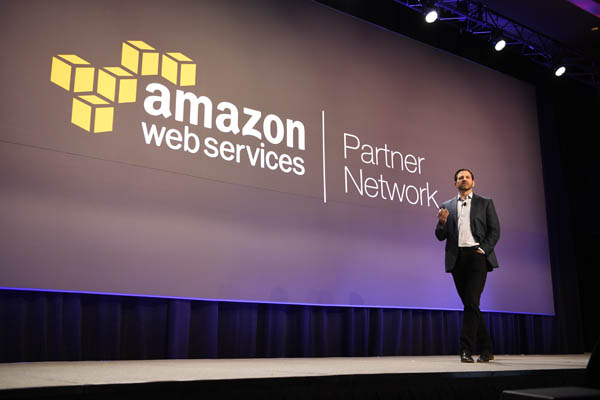LAS VEGAS – Is it possible to show up at any airport in the world without your passport and still board your scheduled flight; get to your intended destination and get back home? Today, that idea seems ridiculous, but that is the dream of one Colleen Manaher.
Manaher is not in the technology industry. She is a U.S. Customs and Border Protection Officer. At the 2017 AWS Re:Invent show, Manaher took the stage in full dress uniform and told the audience of her dream of a passport-less, boarding pass-less airport experience. And, it might be coming sooner than you think.
Manaher said, security officers will be going to a transformational change in the service they currently provide. Operations such as the U.S. Customs and Border Protection (CBP) agency is rethinking how they look at and manage identification data. Manaher had a light-bulb moment during a tour of Under Armour, the sports apparel manufacturer, where she learned about just-in-time data along with using data for what you need at that given moment.
Just-in-time data management led to many questions for Manaher such as what if security was managed through a plane’s manifest? Or a cruise ship or land border traffic passenger lists?
“When we look at the data we have there is no ‘me’ in it and we need more ‘me’ if we want to transform border security,” she said.
Manaher is working with airlines such as Delta and JetBlue. Government agencies such as TSA along with cloud provider AWS, technology vendor NEC and consultancy Deloitte to create a new vision of security for passenger travel.
“Let’s say you are at home and on your couch and you suddenly need to get to London and be back home in three days. What do you do? You’ll go on your laptop and there will be a facial recognition app that will capture your image and that image will be sent to CBP. We already know 98 per cent of the people who travel already. So, you are on your way to the airport and you have baggage to check in. You will not have to show your passport or your boarding pass. Instead your face will check in your bag. TSA security will be waiting for you and more importantly they’ll know that you’re coming. They know this because CBP will have told them,” she said.
All this will be done with a tablet device using a plane’s manifest. The passenger check-in process will be done ahead of time.
The second part of this situation is a person’s travel going home. Manaher said, the process for that will be as simple as sending a text message welcoming you home and informing you to report to global entry and there is no waiting line.
This new airport screening process is being piloted right now at JFK Airport in New York. Manaher said that behind the curtain its all about the image the traveler sends, through the cloud, to CBP. “And, this all happens in two-seconds with AWS services such as EC3, RDS, Cloud Watch, Glacier and Direct Connect,” she added.
The promise of a passport-less airport experience will be about video analytics and machine learning. “It’s a face on the move,” she said. Manaher went on to say that CBP will be able to look into a crowd and know where a man named John is. “This is the future.”
VANCOUVER INTERNATIONAL AIRPORT
Beyond the JFK pilot, two Vancouver-area solution providers TriNimbus Technology and Innovative Travel Solutions, which is an independent business that works inside the Vancouver International Airport is also working on similar passenger processing challenges.
Innovative Travel Solutions has already developed a BorderXpress kiosk for the airport. There are more than 1,200 of these kiosks through airports in Canada, the U.S., the Caribbean and in Pacific Rim countries.
The Vancouver Airport Authority is Canada’s second busiest airport and serves approximately 22.3 million passengers a year. There are 55 airlines at the Vancouver Airport and it can enable people to get to more than 125 countries around the world.
These kiosks were hosted on two on-premise data centres right inside the Vancouver airport. This ended up being tough to support for those machines outside the city of Vancouver.
Innovative Travel Solutions wanted to scale this solution because the company knew it was growing fast and there were plans to deploy more of these units at other airports. The idea of the virtual server came about, but for that to work security needed to be a major focus because of the confidentiality of the data being processed.
With TriNimbus, the first AWS channel partner in Canada, Innovative Travel Solutions were able to move BorderXpress to the cloud with a new design and configuration strategy.
The TriNimbus solution consists of a similar plan that is being piloted by CBP in JFK with Amazon Elastic Compute Cloud instances to support the airport’s application and supporting servers. The solution also takes advantage of Elastic Load Balancing to automatically distribute incoming traffic between multiple Amazon EC2 instances.
In addition, the design uses multiple Availability Zones for redundancy.
On top of that, Innovative Travel Solutions uses Amazon Relational Database Service (RDS) for its database platform, incorporating the service in a multi-Availability Zone configuration for redundancy.
In terms of storage, Amazon Simple Storage Service stores all the backups and Amazon CloudWatch proactively monitors these EC2 instances.
The TriNimbus solution is now being used in 34 airports in Canada, the U.S., the Caribbean, and some Pacific Rim countries. One of the added benefits of this cloud solution is that border-control now has around the clock guaranteed high availability for kiosk apps. App uptime along with system updates through AWS CloudFormation templates are now seamlessly refreshed on virtual servers.
Under this solution, the airport can add new virtual servers as needed.
Innovative Travel Solutions is working on developing a commercial version of this solutions so that they can distribute it to other airports around the world.






